How to care for a hybrid tomato "Palenka" for a better harvest
Dutch breeders spent a lot of time and effort developing the Palenque hybrid. The result exceeded expectations: the crop harmoniously combines record yields with excellent taste.
After numerous tests, the hybrid was entered into the State Register of the Russian Federation. Palenque tomatoes are known in all regions not only among amateur summer residents, but also among professional farmers.
Description of the hybrid
Palenca is a hybrid, not a tomato variety. Its characteristics and description indicate high productivity even in unfavorable conditions. The plant is indeterminate, with unlimited growth of the main stem.
The height reaches 2 m and therefore requires gartering and pinching of plants. The foliage is medium, the leaves are rich green, the branches are spreading. The first flower cluster is placed above the 9th leaf, the next ones every 2-3 leaves. Each brush produces 5–7 ovaries in all weather conditions.
Mid-early species: harvesting begins 105–115 days after emergence. Tomato is immune to a number of dangerous diseases, such as: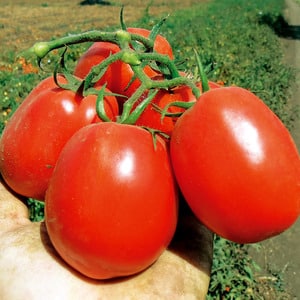
- tobacco mosaic virus;
- fusarium and verticillium leaf wilt;
- cladosporiosis (brown spot);
- root rot.
These diseases have different etiologies: viral and fungal. Both are equally dangerous for plants. During an outbreak of infections, most of the plantings are destroyed. When damaged by fungi, seedlings can be cured by identifying the disease at an early stage.However, a viral infection is practically untreatable. Therefore, a big plus for any culture is its immunity.
In addition, neighboring plants can also become infected, as happens with brown spot, tobacco mosaic, fusarium and verticillium. With these diseases, the appearance of the leaves and their color are modified. Subsequently they wither and the plant dies. Root rot causes rotting of the roots and death of stem tissue.
Despite Palenca's strong immunity against many dangerous diseases, it is practically not protected from late blight. Therefore, you should take care of the necessary preventive measures in advance.
Yield indicators
The culture is recommended for cultivation under film cover and in greenhouse conditions. Nevertheless, in the southern regions, tomatoes are successfully grown in open beds, although under such conditions high fruiting rates cannot be achieved.
Reference. The creator of the hybrid claims high productivity only in closed ground.
When planted in a greenhouse, 6-7 kg of excellent fruits are collected from 1 seedling, provided that no more than 3 plants are planted per 1 m2.
Description of fruits
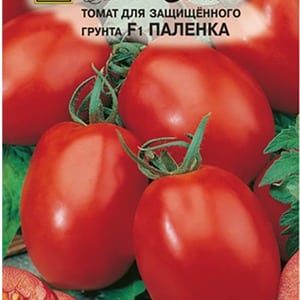 The photo shows Palenque tomatoes.
The photo shows Palenque tomatoes.
The average weight of ripe tomatoes is 100–130 g, oval in shape, slightly elongated, similar to cream. The color is deep red, the taste is excellent, sweet, with a pronounced sourness characteristic of tomatoes.
The pulp is juicy and dense. The peel is thin, but strong enough for long-distance transportation. For long-term storage vegetables retain their presentation. For these reasons, the variety is a success among entrepreneurial farmers who grow it on an industrial scale. Ripe tomatoes are in great demand in markets.
The purpose of the fruits is universal: they are suitable for preparing various fresh dishes, winter preparations and processing into tomato products.
Pros and cons of a hybrid
Each crop has its own advantages and disadvantages. Palenque is no exception.
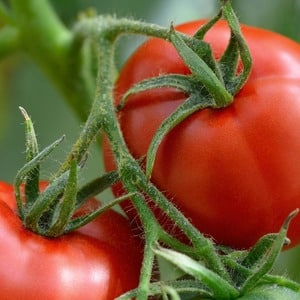 Let's start with the positive aspects:
Let's start with the positive aspects:
- adaptation to any weather conditions;
- possibility of breeding in all regions;
- formation of ovaries under any conditions;
- high-yielding variety;
- resistance to dangerous diseases;
- simple agricultural technology;
- excellent taste of fruits;
- unusual shape;
- long-term storage;
- transportation over any distance;
- versatility in cooking.
Among the existing negative properties it is worth noting:
- necessity garters;
- regular stepsoning;
- weak immunity to late blight;
- mandatory installation of trellises.
Features of cultivation
To obtain strong and healthy seedlings, it is important to adhere to certain rules: the timing of sowing seeds and planting seedlings in the ground.
Sowing seeds and first shoots
Experienced gardeners know that seeds of hybrid crops will have to be purchased for each planting. Of course, you can collect the material yourself, but this does not make any sense, since hybrids do not retain their parental properties in the next generation.
Purchased seeds do not need to be treated with a growth stimulant or disinfected: the manufacturer takes care of this himself.
Reference. You can buy Palenque tomato seeds at any specialty store. Distribution is carried out by agricultural firms "Partner" or "Semco Junior".
The soil is prepared from peat, turf soil and humus in equal quantities. A little potassium fertilizer and superphosphate are added to the resulting mixture for greater nutritional value.Then pour over a hot solution of potassium permanganate to destroy pathogenic spores.
For sowing, a common wooden box is used, followed by transplanting the seedlings into individual containers. The box is treated with a dark solution of potassium permanganate and filled with soil.
Seeds are planted in furrows 1.5 cm deep and at a distance of 2–2.5 cm from each other. Moisten with a spray bottle with warm, settled water and cover with film. Planting containers are left in a warm room at a temperature of 23–25°C.
Reference. To obtain healthy seedlings, it is important to maintain the correct temperature conditions.
After the shoots emerge, the film is removed and the containers are placed on the windowsill. The temperature remains at the same level for 2 weeks.
Seedling care
Water the seedlings moderately, as the top layer of soil dries out, with warm, settled water using a shallow watering can. There is no need to flood the soil; this risks the development of fungal diseases.
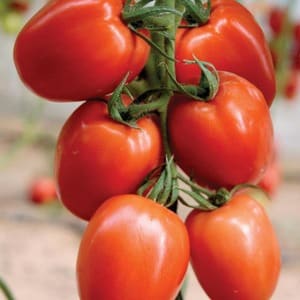 Afterwards, the soil is loosened superficially, improving the air permeability of the soil.
Afterwards, the soil is loosened superficially, improving the air permeability of the soil.
As the seedlings take root, the temperature is reduced to 20°C. At lower values, the first flower cluster will form too low, which will negatively affect the further development of seedlings.
When 3 true leaves form, the seedlings are picked and placed in separate containers. They are prepared in advance: they are treated with a strong solution of manganese and small drainage holes are made at the bottom of each container to drain excess moisture. Containers should not be less than 500 ml, since each bush needs a lot of space for full growth.
2 weeks after picking, the seedlings are fed with liquid fertilizer for tomato seedlings. Fertilizing must be combined with watering.
2 weeks before planting in the ground, seedlings begin to harden in the open air during the daytime. Initially, it is left outside for 1 hour, gradually increasing the time to 11 hours. This procedure helps seedlings quickly adapt to new conditions after transplantation. In addition, the seedlings are fed again with liquid fertilizer.
Bedding
The soil for tomato beds is prepared in the fall. The earth is dug up and humus, ash and superphosphate are added. In the spring, they dig it up again and spill it with a solution of potassium permanganate.
After the soil warms up to 18°C, the seedlings are transplanted into shallow holes at a distance of 50 cm from each other. At 1 m2 place no more than 3 plants in a checkerboard pattern.
If the soil has not warmed up to the required level, replanting should be delayed, otherwise the young bushes will shed their ovaries.
Palenque tomato care
With proper care of the hybrid, gardeners achieve record fruiting rates. Proper watering is one of the necessary conditions for the full growth and development of seedlings.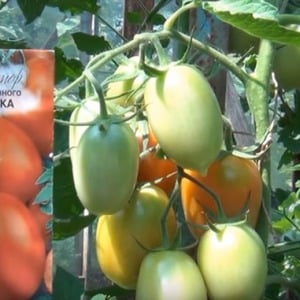
Watered them regularly, as the soil dries out, with settled water. Lack of moisture affects the developing fruits: they do not gain weight and crack. However, it is also impossible to over-moisten the soil: excess liquid threatens the development of fungal diseases. Do not forget about daily ventilation of the greenhouse, as this helps to avoid increased levels of humidity.
After watering, the soil is loosened and weeds are removed. To prevent the beds from drying out, they are mulched.
Immediately after transplanting, it is worth installing a trellis on which the stem and fruit-bearing branches are tied.To do this, install metal supports on different sides of the bed and stretch a wire between them, onto which the plants are fixed with soft fabric tapes.
Reference. When breeding a hybrid, you cannot do without installing a trellis.
Form a bush into 1 stem, removing all other stepsons as they grow. Plants are planted regularly throughout the growing season. The lower leaves up to the first flower cluster are removed. This not only protects the plant from diseases, but also promotes better ventilation.
Feed the crop every 2-3 weeks. As fertilizing use a full range of mineral fertilizers and organic matter, alternating them with each other. This way the bushes receive all the necessary substances.
Harvesting
The collection begins in June and continues until autumn. Throughout the entire period, the bushes are decorated with elegant plum tomatoes, which look impressive in any garden plot.
Ripe vegetables can be stored for quite a long time without losing their presentation and taste. For these reasons, they are in great demand in markets. Entrepreneurs are aware of this feature and successfully breed the hybrid on an industrial scale.
Prevention of diseases and pests
The culture is resistant to many tomato diseases, but weakly resists late blight. Timely preventive measures will help protect plants from fungal infection.
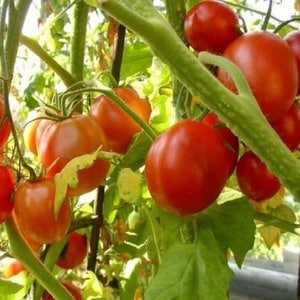 Increased humidity and temperature are considered favorable conditions for the development of the disease. To eliminate such factors, protected structures must be ventilated daily. Fresh air destroys not only pathogenic spores, but also the usual conditions for the existence of many greenhouse pests.
Increased humidity and temperature are considered favorable conditions for the development of the disease. To eliminate such factors, protected structures must be ventilated daily. Fresh air destroys not only pathogenic spores, but also the usual conditions for the existence of many greenhouse pests.
During the growing season, the bushes are treated with fungicidal preparations, and the soil is spilled with copper sulfate before replanting. According to the rules of crop rotation in a greenhouse, the top layer of soil must be replaced every year. Thus, pathogenic microorganisms do not persist in the soil and the new soil will be rich in nutrients.
When affected by fungus, plants are sprayed with “Fitosporin” or “HOM” is used.
To scare away pests from tomato beds, crushed cloves of garlic are dug into the ground, sharp-smelling herbs are planted next to the bushes, and the seedlings are sprayed with decoctions of nettles or onion peels.
Do not forget about regular thorough inspection of each plant. This will help prevent the development of diseases or the accumulation of parasitic insects in time.
Farmer reviews
Everyone who grew tomatoes in their beds leaves positive reviews: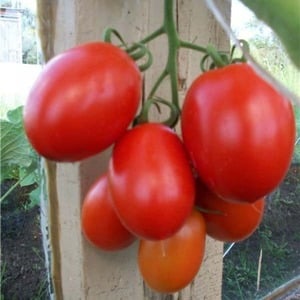
Elena, Zelenogorsk: «The tomato hybrid Palenque is very profitable. You have to work hard with the formation and pinching of the bush, but the harvest is worth it. The fruits are tasty and can be stored for a long time. Fruits until frost and longer if the greenhouse is heated. It’s a pity that it’s impossible to collect seeds yourself—all the signs are lost.”
Valery, Moscow region: “I was interested in the photo and description of the hybrid. I planted it for the first time and am very pleased with the result. The stem is very powerful. The yield is excellent: it was enough for us and provided for all our friends. Excellent tomatoes for fresh salads and preparations. I will plant again."
Conclusion
Tomato Palenca F1, despite being somewhat demanding in care, has successfully taken root in many beds.The hybrid is valued as a high-yielding member of the nightshade family, well adapted to weather conditions and resistant to many diseases. Due to their excellent taste and attractive appearance, the fruits are successfully used for commercial purposes.